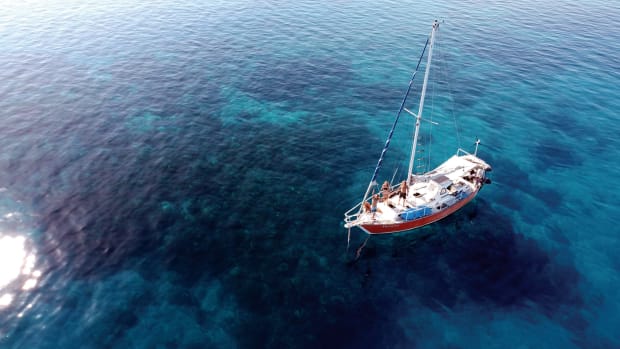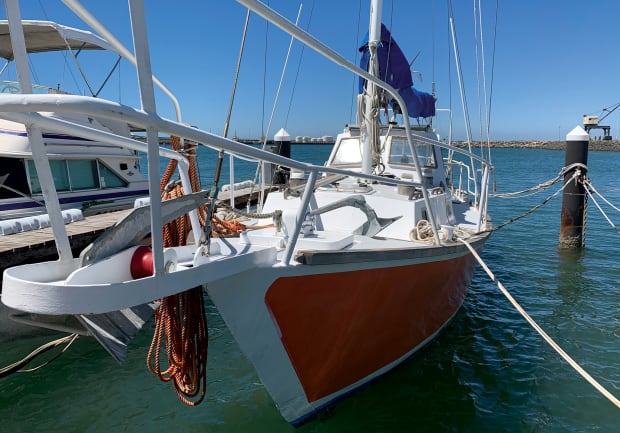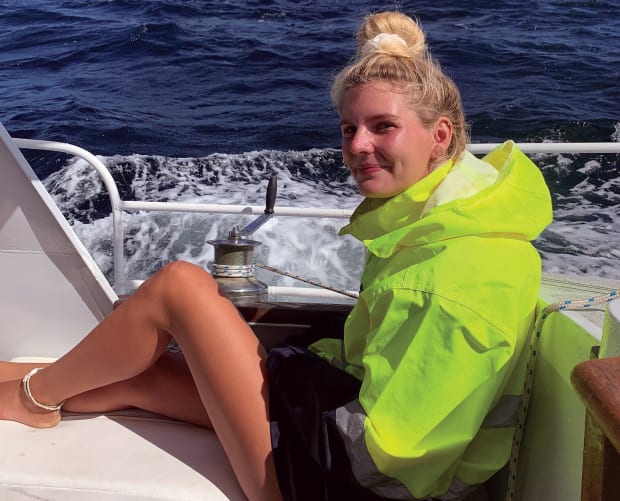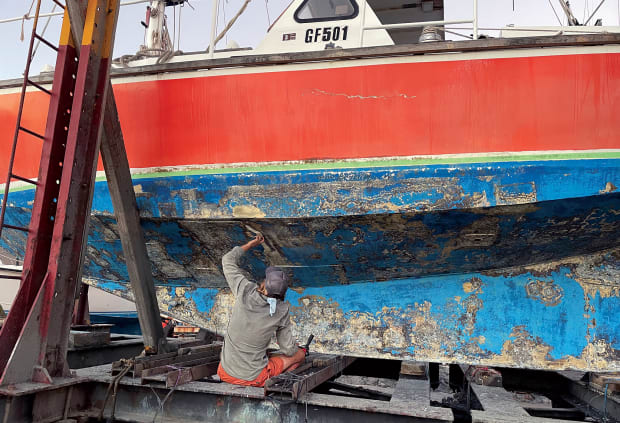
Photo by Tim Coles
The idea of packing it all up and going cruising is simultaneously massively appealing and daunting. To a young sailor, it can feel almost impossible, but I’ve learned a few things that have changed my perspective significantly.
My partner, Sara, and I (combined age of 48) raised a few eyebrows in the family when we purchased a 35-foot steel “project” boat for the princely sum of $11,000 AUD (about $7,600 U.S.), spent two months at anchor repairing and refitting the important bits, and made our way north from Perth, Australia. We eventually crossed the Timor Sea into Indonesia, our Australian work visas having expired, and are currently cruising west near Lombok.
Being on a boat, and an old one at that, we’ve had to deal with numerous breakages and difficulties along the way. Still, the entire experience has unfolded more easily than I’d ever have imagined, leading me to believe I should’ve started earlier. It’s also made me rethink the common myths that can dissuade younger sailors from living their dreams of rum-soaked sunsets and faraway palms—dreams that could be closer than they think.
So, in hopes of helping shake the oft-held (but rarely substantiated) idea that cruising is for the retired, rich, and/or idle, I’m sharing a little of our story and a few of the insights I’ve gleaned along the way to help debunk those myths.

Photo by Tim Coles
Myth 1: Yachts are expensive to buy.
Categorically not true. Yes, beautiful, fresh production boats are expensive. Turnkey bluewater cruisers are expensive. Almost every boat listed on popular brokerage sites is expensive, as are those whose images festoon yacht club walls. But that lovely timber boat that’s been sitting in the yard for five years, gathering dust and guano as the owners pursue other interests and rack up storage fees, well, you’d be surprised. The guy who spent 30 years building a testament to detailing, only to encounter 50-knot winds with his family on their third sail—he wants out. The couple who bought ferro and couldn’t get insured or into a marina—they’re over it. The club racer whose boat is now dated and outclassed—she wants to upgrade.
I’m certainly not gloating over anyone’s misfortune—I honestly wish every sailor nothing but dolphins on the bow and 15 knots on the beam—but the realities and trade-offs of modern life mean that many boatowners are simply not able to enjoy their boats as they’d like to, and many seek an exit, sometimes at an astonishing financial loss. In some places, the pandemic has only exacerbated this, particularly for boats left in cruising end points such as Langkawi, as many haven’t been able to get to their boats and are deciding to sell rather than to face catching up on three years of maintenance in a foreign port.
I’m not suggesting that you look for old lemons, but there are undervalued yachts or owners keen for a quick sale at every end of the price spectrum, and with a bit of luck you may find a bargain. We know one friend who bought a 38-foot sloop, perfectly laid up and rigged but sans engine, for $6,000—a steal. Another friend got a Radford 35, beautifully constructed but horribly maintained, for $20,000. That’s still pretty expensive, but when you realize that the previous owner/builder had invested upwards of $200,000 into her before his wife decided she didn’t much like the sea, it starts to sound rather good.
I’ve seen numerous ads for boats in the $5,000 to $10,000 range that are horrible money pits, but a few absolute gems. I’ve even seen free boats that would require a bit of time and investment, obviously, but that could become capable cruising boats for less than what you might expect to pay for a decent car—and they’d get you a lot farther.
Once you narrow your goals and focus on only what you need, you sidestep a lot of the additions that seem to drive prices up. We got lucky with our setup and systems, but a major point for us was not worrying about resale value. We decided to buy what we needed to get going, realizing that even if we got nothing back after a few years (most unlikely), the money saved on rent is about equal to the boat value. (Interestingly enough, we’ve since had offers that seem to indicate a fairly decent appreciation in value, not something I’d have expected.)
We also live in the age of eBay, Marketplace, and Gumtree. It’s never been easier to view and vet hundreds of these private sales, all over the world, and though this does drive competition up, it also means you are no longer limited to kicking around your local yard or closing brokerage pages in anguish.

Photo by Tim Coles
Myth 2: Bring on another thousand…
…i.e., boat maintenance will be a death by a thousand cuts to your finances. Again, only partially true. If you get a yard to do all your work and marine professionals to fix everything, you could spend many times the value of your boat in no time. But if you’re keen to learn how it actually works, you needn’t go that route.
We’re in the age of YouTube and online forums, and without much difficulty, you’ll find answers to most questions and solutions to most problems (and many, many opinions). Some jobs are undeniably professional territory, but being young, courteous, and keen may help your case.
We made a deal with a lovely sailmaker that we’d do all the unpicking (removing the old threads) and help him as much as possible in return for a slight reduction in his rates. We spent two days learning under his instruction, recut an old genoa, removed and reattached a bolt rope, and shortened the luff. Quotes from three sail lofts for the same job ranged from $1,000 to $3,000. We paid $150, learned heaps, and made a good friend.
Ah, you say, that’s just one guy—you got lucky! Well, we did, but after dealing with about seven different people, always courteously and expecting nothing special, we paid on average 30% of the normal quoted rates by offering help at every stage, only reaching out when we hit dead ends, and not pushing for picture-perfect solutions. Almost every tradesperson was happy to see us getting into the boat life and was very understanding of our financial situation and willing to accommodate.
We were certainly privileged to receive this kind of treatment, and one of our older sailing friends actually mentioned this one day: “No one wants to give grumpy old gits good deals!” We had a good laugh, but there’s certainly an inkling of truth there, and I sometimes feel prices are artificially inflated to make it worthwhile for tradespeople to put up with archetypal rich, entitled, pushy boatowners. Come across as the antithesis of this and you’ll often find a pleasant surprise.
There’s also, of course, the cruiser community backup. Sooner or later, you’re bound to bump into someone with the exact skillset to solve that one annoying problem that’s evaded you for months. In our case it was our AIS system that was getting terrible coverage due to a phenomenally high VSWR (voltage standing wave ratio—basically a measure of how effective your radio antenna and cabling are). It drove me mad trying to remedy, and after spending a fair bit on parts that might’ve solved it but didn’t, I resolved myself to a semi-operational system. Marine technicians advised me to leave it, as it would be far out of my capacity and budget to fix or have them fix, and so we continued sans great radio range.
Enter Ryan, a good friend we made while surfing and cruising Indonesia. As we sailed between anchorages, he noticed our VHF range was terrible and offered to help me track down the source. Turns out Ryan is an industrial electrics whiz kid by trade and had diagnostic tools onboard most marine techs do not. He’s also a very good chap and took time to finally solve our problem for good.

Photo by Tim Coles
Myth 3: Good boats take ages.
Also only partially true. We have a friend who has spent 23 years building the perfect boat, and she’s a beauty! But he’s now 71, and although he has made one long passage, he is still in a marina today. He will have to sail to 94 just to spend the same amount of time on the water as sweating over the shell to take him there—which is completely fine if that’s what you enjoy (and he does).
However, most of the sailors I know work on their boats out of necessity, not pleasure, and although there are a million and one things that would be nice to have or do, the fundamentals are all that’s really needed to get going safely. At first, I wanted to redo our woodwork, repaint most of the boat, organize beautiful stack packs, and generally go crazy making our new home shine, but I quickly found that if I were to do everything I’d initially planned, I, too, would be 71 before I got anywhere.
We spent two months working, living, and most importantly sailing the boat from the same harbor and quickly discovered what was necessary and what was not. New two-pack epoxy and an antifoul underneath, but no bog and no sandblast. A livable V-berth and a few more shelves, USB chargers, and jerry cans, but no interior refit. Fresh fluids and a new exhaust muffler system, damper plate, and seals, but no engine rebuild.
Being somewhat ignorant and having a relatively high risk tolerance, I decided to forego rerigging, much as I would have loved it, and fitted a furler to the old forestay. This was achieved at a fraction of the price I was quoted to get a (big brand name here) furler professionally fitted by ordering a sturdy, but cheaper, furler online, and then constructing and fitting it at anchor with the help of a friend.
With the fundamentals now covered, we could begin safely sailing our new pride and joy only a few weeks after purchasing what many had derided as a project boat. And yes, we certainly have come across new problems—we’ve had to replace batteries, rewire the autopilot, install new engine mounts, and redo our alignment and stern gland along the way—but these have not caused us undue difficulty. Had I seen to everything on my list of “Want To Do’s” I’d be broke, in a marina, disillusioned, and unsatisfied.
Again, the question of risk tolerance looms large, and everyone will draw their own line between safety and expense, but in my mind, there are a number of things that one can let be without life-threatening consequences. If it tips the balance between having perfectly oiled teak decks and actually getting out there on the big blue, well, I’m sure you can guess my answer.
Myth 4: All yachties are old.
There was a point, when we were running around refitting and I was squeezing every old salt for advice, when Sara looked at me and almost shouted, “I can’t take it anymore! All your friends are grandpas!” And to be honest, at that point she was right. The median age of my friend group rocketed about 50 years as a direct result of exposure to the yachting community (or a subset of it at least), and we were beginning to wonder if it was just us and Sailing La They-Who-Must-Not-Be-Named in the under-40s category.
I’m in no way saying this is necessarily a bad thing. I got on fantastically well with my new friends, learned more than I’d be able to learn in a lifetime by myself through their kind advice, and heard some incredible tales. But needless to say, we were longing for contemporaries, younger cruisers who were on a similar path, shared our worries, excitement, and the same taste in sundowner music—sailors we could relate to as equals and not as students.
It didn’t take long to find them. As we progressed along our journey and strayed farther from civilization, the median age of the cruisers we met dropped, as if inversely proportional to our distance from any major city. And that’s when I realized most of our cohort were out there already, living out their sailing dreams on deserted beaches and tiny islands far from the madding marina. We’ve since met countless other younger people with the same outlook as ourselves, forged amazing friendships, shared knowledge, and even had electro groove sundowners!

The first job was to strip and repaint the bottom, saving thousands with DIY.
Photo by Tim Coles
Myth 5: Sailing is difficult.
Perfect sailing is difficult, some may say unattainable. Safely getting yourself from A to B with the use of the wind is not particularly difficult at all. Although I was lucky enough to start with a fair bit of experience in dinghies and small yachts, I was by no means an expert and still am not. However, most of the time the stakes are reasonably low, and there is ample time to learn through practice and experience.
Trim your sails poorly? Sure, you’ll be a bit slower, but it’s nothing you won’t live through and learn from. Mistime a tide? You may be very slow, touch sand, or have to wait to get into an anchorage, but you’ll know for next time. Too much canvas up in a blow? A few gut-wrenching gunwale dips and you’ll soon realize the error in your ways and (hopefully) be able to remedy it sharp.
Of course, the stakes can be higher—far higher at times—but as a sensible human, you’ll know what these situations look like, when they are likely to occur, and how to prepare yourself, crew, and boat accordingly. We met a young couple, neither of whom had any prior sailing experience, in an isolated anchorage with a rather technical reef entrance just eight months after they’d bought their boat. Initially I was amazed that they’d made it that far, having thought it a rather tricky bit of sailing to get there (about 600 nautical miles from our shared departure point) and into the anchorage, but they were happy and confident in their abilities after their months of learning by doing.
In fact, as a full-time cruiser, you’d be hard-pressed not to become a fairly good sailor quickly, as it’s almost all you’ll be doing and focused on. The beauty of sailing is that few, if any, could claim to have mastered it—there is always something more to learn, a technique to refine, or a bit of theory to revise. In that regard we are all learning every minute we’re on the water, just at different points on a spectrum, and there is never any shame in asking those in the know for some tips. Get a basic grip on the main ideas, consider a sailing course, study emergency and safety points as well as you can, and then just get out there! It’s worked for countless people across the ages—and that was before fantastic handbooks, easy connectivity for questions, and YouTube tutorials.
Myth 6: You must save before you go.
An enduring (and one of the only endearing) features of the pandemic is the new prevalence of remote work. Most people, and, importantly, their employers seem to have realized the futility of the crowded modern office, a grueling daily commute, and the time lost to water cooler chit-chat. The pivot to remote work has meant that anywhere with space for a laptop, a half-decent internet connection, and (maybe) a kettle is now a usable workspace. Most cruising boats and locations will fulfill these requirements for at least some of the time, so with a bit of careful planning and maybe some investment in network equipment, the world is your office. This may negate the need to wait for retirement or to feel like you must have every penny saved pre-departure, as you can top up your cruising kitty with (hopefully) some regularity.
Of course, this depends on your line of work and ability to reassure your superiors that you’ll be able to meet their requirements, but it’s not limited to tech-savvy IT dudes, web designers, and hedge fund managers. We know a hairdresser friend who does pretty good trade at anchor, artists who sell as they go, and marine technicians who make a killing.
So, get going!
A recurring theme among older cruisers I’ve spoken to is that they wish they’d started earlier. Although everyone’s situation is different, I am a strong proponent of the idea that the sooner one tries, the better.
Sailing is more accessible than ever. A glut of older boats on the market, GPS and modern navigation, multiple sources of learning material and information, remote work, and a helpful community mean that this lifestyle is no longer the domain of rich retirees, trust fund babies, and societal dropouts. It’s simultaneously the easiest and hardest thing you may do, but the rewards and satisfactions are boundless, so don’t let the myths hold you back.
Tim Coles is a 25-year-old cruiser with a degree in marine science, currently in the Telo Islands with his partner, Sara, and Able Cat Tiga, aboard their old 35-foot steely, Restless. Follow him @restless_sails on YouTube or Instagram.
April 2023








